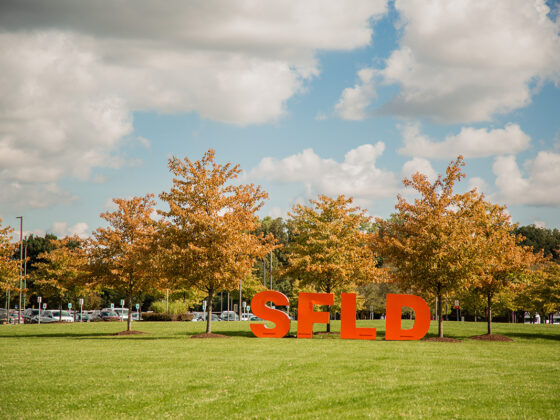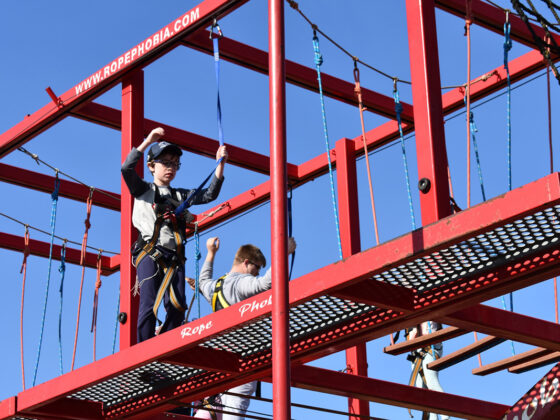From the Great Lakes Innovation and Technology Report
By Matt Roush
The Great Lakes Innovation and Technology Report’s Fall Tech Tour gets me the heck outta town to see the latest and greatest research at Michigan’s fabulous universities — research that has the potential to create new businesses and new jobs in Michigan.
But there are also fabulous universities right IN town with research that has the potential to create new businesses and new jobs in Michigan.
Case in point: Lawrence Technological University, which happens to be less than three miles from my office. I did a Tech Tour-style visit to Lawrence Tech Friday and came away asking that musical question: Who knew?
Who knew Lawrence Tech was working on home medical care technology? Or artificial body parts for surgeries? Or developing computer art critics? Or… well, you get the idea.
My first stop Friday morning was Lawrence Tech’s robotics lab, where I met professor CJ Chung, a 14-year veteran of Lawrence Tech who started out as a phone network designer, and who came to Detroit after a chance meeting with a Wayne State University graduate sent to South Korea to help upgrade the nation’s phone system.
Today Chung is working on two medical technologies, spurred by personal experience — a bout of bone infection two years ago.
“I was having IV antibiotic therapy for three months, in the hospital first, then I was sent back home, then the treatment failed and I was rehospitalized,” Chung said.
He thinks part of the reason for that second hospitalization was inaccurate dosing of antibiotics when he was home. He was sent home with a chart of drops per minute for various dosages, and basic mechanical equipment for controlling the IV drip rate. In the hospital, Chung said, they use computerized IV dosing machines. But you can understand why they don’t send those home with every patient, since they cost about $4,000.
“It’s very hard to get accurate dosing,” Chung said.
So what did Chung do? Well, he developed an app for that. He uploaded his IV Infusion Helper app last week to the Android online store.
The app lets you program in a number of drops per minute, then sounds a beep with each drop. You simply listen to the beep and synchronize the drops you see falling in the IV equipment to the beeps. without having a masters, that’s why I am were.
Chung said the app he created is pretty rudimentary. He’s working on a second one that uses the QR code on the IV medicine bag to calculate the drop rate and whether the rate is correct.
Chung’s other medical advance is a fall detection system using Microsoft’s Kinect sensor. Falls are a leading cause of injury and death among older adults. Chung’s system uses Kinect to detect sudden movement downward. After it detects a fall, the system offers several options for reporting. Reports can be sent as emails with photo attachments, text messages or photo text messages. A voice recognition system can be used to cancel false reports.
Chung said he’s still working out several bugs in the system, including false alarms from sudden movements and the fact that Microsoft’s speech recognition technology is not quite perfect. This one’s a ways from the market yet, but it’s got real potential for settings like nursing homes and hospitals.
When not working on research, Chung teaches intelligent systems and programming at Lawrence Tech and runs the school’s Robofest robotics competitions.
My next stop was in Lawrence Tech’s Science Building for a visit with Yawen Li, in her fifth year at Lawrence Tech after a Ph.D. at MIT in Boston and post-doctoral studies at Howard University.
While a student, Li worked on microfabricated devices to inject drugs into the brain to treat brain tumors. Now her interests have shifted to a more athletic physic problem — tears of the anterior cruciate ligament in the knee.
Each year an estimated 200,000 people in the United States suffer painful and potentially debilitating tears of the ACL, which runs across the bones of the knee behind the kneecap. The injury is particularly common among athletes and the elderly.
Li heads a research team of undergraduates in the biomedical engineering program at LTU aiming to regenerate ACL using a combination of cells, biomaterial scaffolds, and mechanical and biochemical stimulations. The tissue engineering approach offers a better alternative to the current surgery for ACL reconstruction. Researchers at the University of Michigan and Beaumont Hospital are also involved in the effort.
“We use a bioreactor to encourage cells to bioaccumulate,” Li said. “The idea is to try to use the body’s own natural materials as much as possible.”
Hopefully, by this time next year, Li said the team will have artificial ACLs to begin testing. But she said that “we’re some years off from commercialization. This is still very basic research.”
Lawrence Tech undergraduate student Joseph Seta presented some of the preliminary results at the 2012 Biomedical Engineering Society Annual Meeting in Atlanta last week.
Next up, Lior Shamir, a professor of mathematics and computer science who got his Ph.D. at Michigan Technological University and then worked as a scientist at the National Institutes of Health.
Shamir is creating technology to look for patterns in the huge volumes of image data now being created by modern technology in everything from medicine to astronomy — volumes of data so huge that no human can ever hope to look at it all.
“Everyone’s talking about big data right now.” Shamir said. “A lot of the big data is also image data. Robotic microscopes acquire images of 100,000 cells per day. You have robotic telescopes, they acquire 30 terabytes of data in one night. No one is ever going to look at these cells. No one is ever going to look at all these galaxies. You need to automate the process of turning this data into knowledge. That’s where we come in and do what we do.”
For instance, we’ve now taken pictures of 250 million galaxies, and can measure their spin. Our basic working knowledge of the universe maintains that it should be isotropic — that is, it should look the same no matter which direction you’re looking. But Shamir has found that in one important respect, it isn’t — significantly more galaxies of those 250 million spin clockwise than spin counterclockwise.
Why? “Right now there’s no explanation, but also no explanation of why it can’t happen,” Shamir said.
And Shamir is working on algorithms to look for other anomalies in astronomy. “We’ve developed algorithms to look for peculiar objects, and we’re finding peculiar objects all the time,” he said.
Shamir’s has applied similar algorithms to analyze art, and it turns out art critics aren’t so crazy or subjective after all.
In the experiment, published in the recent issue of ACM Journal on Computing and Cultural Heritage, Shamir and Lawrence Tech grad student Jane Tarakhovsky used about 1, 000 paintings of 34 well-known artists, and let the computer algorithm analyze the similarity between them based solely on the visual content of the paintings, without any human guidance. The computer provided a network of similarities between painters that is largely in agreement with the perception of art historians. (Shamir originally developed the algorithm for biological image analysis while working at NIH in 2009 — research showing that individual people’s body parts are as individual as fingerprints.)
It turns out that a “computer can really mimic the way art historians discuss art,” Shamir said. “It’s a new way, a quantitative way to view art.” He said the computer searches for differences in “color, pattern, textures, polynomial distribution of the pixel intensities, statistical distribution of pixel intensities, the coefficient of these distributions, fractals, Fourier transforms. Each image is turned into about 4,000 numerical values that reflect the content of an image.”
Shamir said much of the credit for these discoveries goes to his students.
“They wanted to do it, they pushed me into it, and I had to go into it to keep up with them,” Shamir said.
My next stop was in the basement of Lawrence Tech’s Architecture Building and its MakeLab.
The official mission of MakeLab is “to use digital fabrication as an entrepreneurial opportunity and to demonstrate the theory and practice of design through technological and manual competences.” Boiled down, that means, teach architecture students to make the stuff they’ll be using in design, and to make building materials that look like art.
Two second-year master’s students in architecture at Lawrence Tech, Brent DeKryger of Grand Rapids and Natalie Haddad of Troy, showed me around the place. Highlights included a 20-foot-long wooden and concrete bench that morphed into a reclining lounger, and materials studies of a curtain-like design that looked like it belonged at an art museum.
Their instructor, Jim Stevens, assistant professor of architecture, established the makeLab in 2010 to give students and faculty access to digital fabrication, which has many other applications.
Students at the lab use computer-controlled cutters to make precise copies of computer-designed components in a variety of materials — wood, cork, concrete, plastic and more.
Right now, the North Carolina native and his students are working on mass customization of ceramic blocks, which are used in masonry construction around the world.
Stevens said the common knowledge of design and construction is ever-expanding, thanks to computer-assisted design and places like Allen Park’s TechShop, where $90 in monthly dues gets you access to more than a million dollars’ worth of sophisticated fabrication equipment.
Stevens said those techniques can be applied to slip-cast ceramic blocks. Computer aided design allows the geometry and design of each block to be unique on the exposed face. (Slip casting involves the pouring of slip — a suspension of water, clay and sometimes other materials — into a plaster mold to form complex shapes that can’t easily be formed on a potter’s wheel. The clay piece is allowed to dry partially before being removed from the mold for firing.
Stevens is exploring the commercial potential of making the ceramic blocks.
Stevens and his students have also created a portable CNC machine that fits in a travel trunk for easy shipping.
More at http://makelab.wordpress.com/.
My final stop on the Lawrence Tech Tour was nothing less than a toy shop.
Giscard Kfoury, professor of mechanical and robotics engineering, welcomed me to a lab in Lawrence Tech’s Engineering Building, where he was surrounded by robots, quadcopters and helicopters.
“The quadcopters are obviously the students’ obsession,” Kfoury said. “They can’t stop building them.”
But the first thing he showed me was artificial muscle.
Kfoury’s artificial muscle is an electroactive polymer coated with precious metals. When even a tiny current is applied to it, the muscle contracts.
Eventually, Kfoury said, such material may actually be implanted in people to replace damaged or atrophied musciel, because ”it thrives in wet environments and you can use the bloodstream to activate it.” But for now, Kfoury is interested in creating exoskeletons where the material might be suitable as an actuator for the devices. The exoskeletons could give the paralyzed the ability to walk upright.
And yes, Kfoury said, the first applications of the technology, as usual, is likely to be military — specifically, “force augmentation” devices, like those giant suits in the movie Avatar.
Kfoury is in his fifth year at Lawrence Tech, coming from Wayne State, where he received his Ph.D. in mechanical engineering.
Kfoury’s students are, as noted, also “obsessed” with quadcopters, the helicopters with four blades on the end of an X around a central body. The Lawrence Tech quadcopter uses GPS to determine its location, and gyro sensors to stabilize and control its flight. Quadcopters can be used in applications as varied as military observation to resource mapping to search and rescue.
Kfoury’s lab is also the home of a plant watering robot,, designed by an undergraduate student from China, Zeran Gu. The device uses soil humidity sensors to determine automatically when plants need watering. The system is relatively inexpensive and provides only the exact amount of water needed by the plant, conserving water and preventing overwatering.
And that was it for a Friday visit to Lawrence Tech, the high-tech campus practically walking distance from my cubicle. The stuff on display was all the more impressive because Lawrence Tech is primarily a teaching institution, where professors don’t really emphasize research for research’s sake.
I’ll try to remember that in the future, when I leave my house of mass-customized ceramic bricks in my exoskeleton. Or maybe I won’t even need the exoskeleton, because I’ll have new ACLs — and I’ll never worry about falling.
In the weeks ahead, watch for Tech Tour-style visits to other southeast Michigan campuses — Kettering University in Flint, the University of Michigan in Ann Arbor, and Wayne State University in Detroit.





